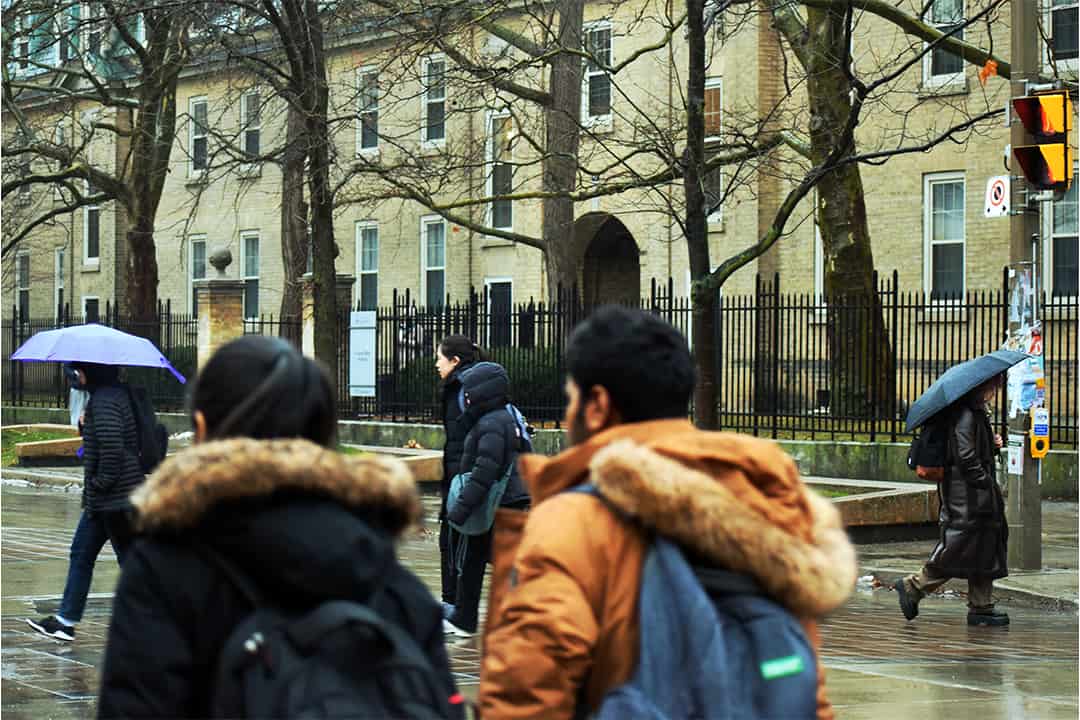Imagine waiting at a crosswalk, watching the traffic light take forever to change. You see a clear road, but the signal insists you stay put. Frustration kicks in, and you decide to cross anyway — that’s jaywalking.
In Toronto, jaywalking is a rebellious rite of passage. It’s the not-so-secret maneuver, a civil disobedience that ignores street conventions and personal safety — and let’s be honest, we’re all guilty of it.
Jaywalking, a clear breach of traffic protocol, is a symptom of the unmet spatial demands of pedestrians in urban centres. In cities like Toronto, pedestrians are subjected to protracted waits at crosswalks and inconvenient signal placements — which all encourage a tendency to jaywalk.
Unmet spatial demands
A 2014 report by the US National Institute for Transportation and Communities found that 85.7 per cent of pedestrians care more about their perception of safety than compliance with the law when crossing an intersection. This data emphasizes the chasm between developers’ intended pedestrian experience and the reality, demonstrating that jaywalking is a manifestation of pedestrian frustrations.
The urban emphasis on vehicular accommodation has relegated many pedestrians in Toronto to places with little-to-no infrastructural support. A 2015 Toronto Public Health report found that “pedestrians account[ed] for 52 per cent of all fatalities and 11 per cent of all injuries from collisions with motor vehicles in Toronto,” despite walking having a modal share — meaning a percentage of total travellers that use it as a kind of transportation — of only seven per cent.
I see this statistic as quite literally a public health emergency, and regardless of whether you think pedestrians are mostly at fault for jaywalking, they are not the party in protected vehicles. Those who drive automobiles are capable of extreme harm and should be reminded that driving is a privilege, not a right.
Possible solutions
You probably hear the buzz phrase ‘pedestrian-friendly infrastructure’ all the time, but what does it really mean? Infrastructure providers such as UtilitiesOne say that wider sidewalks are a major key to encouraging a safer environment for pedestrians in crowded urban centres.
Allow me to break down how wider sidewalks deter jaywalking. First, wider sidewalks provide pedestrians with ample space to move comfortably, thereby possibly reducing congestion and pedestrian frustration. The increased visibility of broader walkways may enhance safety by allowing pedestrians and drivers to spot each other more easily.
Furthermore, wider sidewalks in conjunction with other infrastructure might minimize the temptation to jaywalk by offering clear and accessible pathways for pedestrians to cross roads safely. I believe a more spacious and pedestrian-friendly environment, including well-planned crosswalks, may promote pedestrians’ adherence to designated crossing points and contribute to an overall reduction in risky pedestrian behaviour.
Additionally, the city as a whole is really lacking in investing in crosswalks, pedestrian-only zones, signage, and visibility enhancements such as reflectors on raised pavement markers and larger road signs. Enhanced intersections with pedestrian developments — which include traffic calming measures such as patterned crosswalks — aren’t just pretty paint jobs, but traffic directors that promise safety for anyone outside of a vehicle too.
Picture this: you approach a crosswalk, and the traffic lights work in your favour and prioritize your right of way. Many companies are — dare I say — revolutionizing this future of smart crosswalks. High-tech sensors that detect pedestrians and vehicles on sidewalks and roads, for example — according to a company called Omniflow that develops them — collect “real-time data [which is] then sent to traffic management systems, where it is analyzed and used to make informed decisions.”
Why is this a game-changer, you ask? It’s all about reducing wait times. No more impatient toe-tapping at crosswalks because these smart systems aim to ensure pedestrian traffic flows seamlessly. What do I think the result of this would be? Less jaywalking fueled by frustration and a healthier relationship between all transit modes.
These solutions are by no means exhaustive, but I believe they are the most accessible and easy-to-implement ones relative to other proposals that often impede drivers’ spaces, like re-designed intersections with, for example, sharper curbs.
Using empiricism to solve jaywalking
I see jaywalking itself as a call to action. Thus, I call for a technologically grounded approach by using intelligent systems that empirically adapt to the ebbs and flows of city life and collect real-time data to track when and where the most pressing unmet needs across the city are. Pedestrian blaming also stands as an obstacle to change, as many pedestrians are part of vulnerable populations who cannot drive, such as children and seniors. Once we learn to protect those who make Toronto the city it is, only then can we move forward.
Toronto stands at the edge of redefining its ethos into one where walking is not merely encouraged but scientifically optimized for the well-being of its residents.
Emily Carlucci is a third-year student at Trinity College studying political science and English. She is the Traffic Tango columnist for The Varsity’s Comment section.



No comments to display.